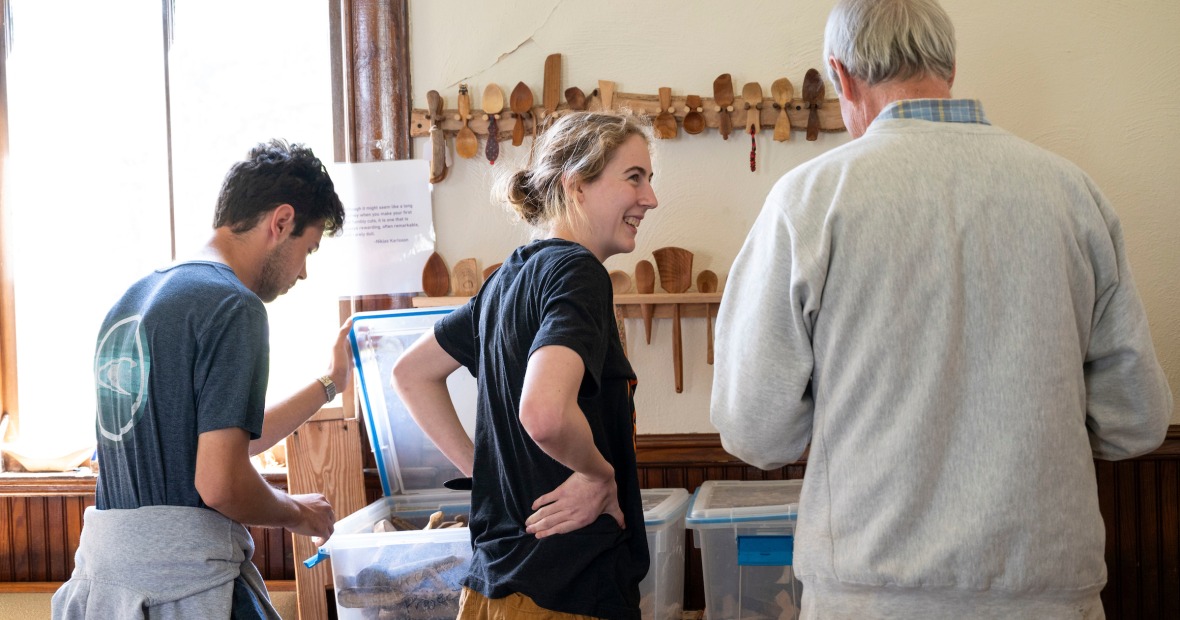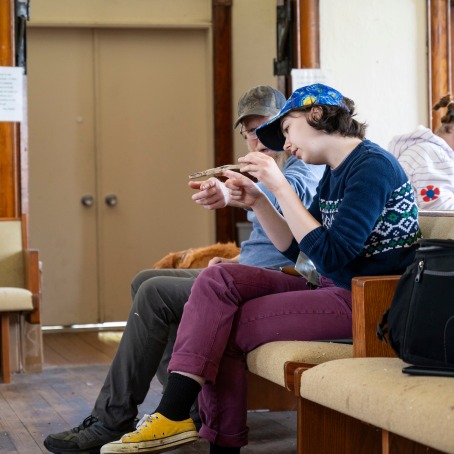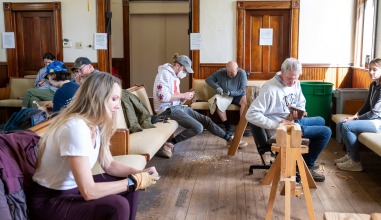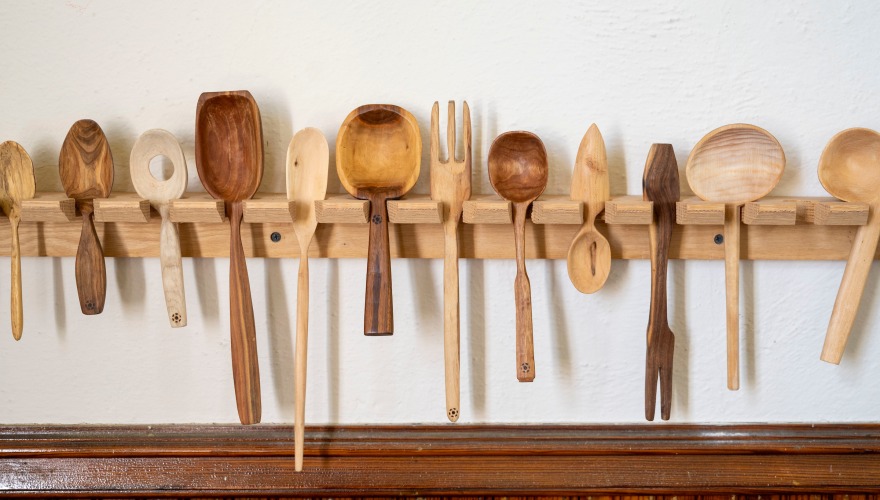Crafting Connections Through Spoon Carving
Grinnell students are involved in all of the typical college extracurriculars — Ultimate Frisbee, a cappella, book club — but they’re also involved in some activities that you probably won’t find on other college campuses. Every Friday afternoon, students, faculty, and staff gather in the Elm Street chapel to carve wooden spoons together. Though few students arrive at Grinnell planning to fill their free time with spoon carving, many have found themselves developing a love for this unexpected new hobby.
“Spoon carving is just the best and has truly been one of highlights of my time at Grinnell,” Grace Couture ’24 says. Couture has been regularly attending the spoon-carving sessions for about two years.
Professor of Anthropology Jon Andelson ’70 and Environmental and Safety Manager Chris Bair ’96 started the spoon—carving sessions part of the Prairie Artisan Series, a project designed to reconnect students with handcrafts and the natural environment. Andelson saw that people in today’s historical context, living in a post-industrial revolution world, have a particular need for handcraft in their lives.
“As the industrial revolution proceeded, fewer and fewer people were doing handcrafting, because now they’re not carving a spoon, they’re going to a store and buying a manufactured metal spoon,” Andelson says.
For Andelson, engaging in spoon carving and handcraft more generally reconnects us with a lost aspect of being human. “Humans and pre-human hominids have been making things with our hands for two or three million years,” Andelson says. “[Handcrafting is] not only very ancient, but very universal, and that makes me feel as if I am doing, engaged in doing something that’s quintessentially human, part of the human experience.”
When one of Bair’s friends had to take down a tree, Bair proposed the idea of using the wood for spoon carving. What attracted him to spoon carving in particular was that it is a beginner-friendly woodworking activity — it requires just a few tools and the carving process is straightforward.
To kick off the spoon carving program, Bair invited an instructor from the Vesterheim Folk Art School to teach Grinnell students the art of Norwegian spoon carving. From there, Bair and Andelson continued hosting the sessions themselves. All wood used is locally sourced, primarily from trees at the Conrad Environmental Research Area that fell down naturally.
While Bair proposed the spoon carving sessions was a way to find a new use for local wood, he now sees the benefit they provide to students as the most valuable aspect of the sessions. “The ultimate goal is just to give students an opportunity to make something with their hands and, at the end of a long week of studies, just sort of relax and whittle,” Bair says.
Students who frequent the spoon-carving sessions agree that it helps relieve the stress of student life. “For me, spoon carving is a time where I can go, listen to a podcast, talk with friends, and make something with my hands without having to worry about when my next assignment is due or when my next class is,” Coture says. “Regardless of what my mood is, I look forward to spoon carving as a source of joy.”
Sophia Unzicker ’26, who has been attending the spoon-carving sessions for close to a year and a half now, says that spoon carving has become a time to relax and reflect. “I really love the creativity and slow pace of carving. It allows me to focus on what I am doing and process the business of the day. I feel like spoon carving is a combination of art and meditation,” Unzicker says.
During a typical spoon-carving session, Bair and Andelson walk newcomers through the basics. Students are provided first with scrap wood. Then, once they’re comfortable with the basic carving strokes, they receive blanks — pieces of wood that are already on their way to becoming spoons so that they don’t have to start with logs. Occasionally, Bair notes, experienced students will choose to start the process with a piece of log and an ax. When a student has completed their spoon, they finish the process by oiling the spoon. “Any time students have worked on a spoon for a while and they oil it and see how pretty it is, that’s always really fun,” Bair says.
In addition to crafting spoons, the sessions also provide an opportunity for students, faculty, and staff to connect with one another. “It’s a tiny little community building effort,” Bair says. “I think it’s an opportunity for students to just get to know each other.”
“Jon and Chris are extremely welcoming and do a wonderful job of making the space feel open and inviting. Everyone who attends spoon carving genuinely loves it, and every interaction is underscored by a sense of mutual appreciation for the space,” Coture says.
“Along with being a great creative outlet, I’ve gotten to know a lot of new people through this group. It’s nice to be in a community space that allows for quiet craft work and conversation,” says Kelly Banfield ’24, who has been carving spoons for about two and a half years.
“I think the community that forms is the best part of spoon carving. Everyone checks in on each other and the slow process of spoon carving invites longer and more meaningful conversation,” Unzicker says. “I think that the leaders of spoon carving, Chris and Jon, really promote the welcoming and communicative atmosphere of spoon carving.”
In addition to fostering community within the group of spoon-carving Grinnellians, the practice can strengthen bonds with those beyond the campus community. The Grinnell Area Arts Council recently featured 12 spoons that Banfield carved as part of a student art salon.
“It was nice to share my spoons with the broader Grinnell community, especially with people who may not have heard about the spoon-carving group,” Banfield says.
Spoon carving can also strengthen bonds with family members or other loved ones outside of the group. “A lot of people who engage in spoon carving end up gifting the things they make to a family member or a friend, and that’s very special. I don’t know if you’ve ever gotten something that somebody made by hand, but it’s different from getting a store-bought gift — I would say more meaningful,” Andelson says.
For students, staff, faculty or community members interested in taking up spoon carving, the group meets every Friday from 3–5 p.m. in the chapel on Elm Street. No experience necessary. Questions about spoon carving should be directed to Chris Bair and Jon Andelson.




